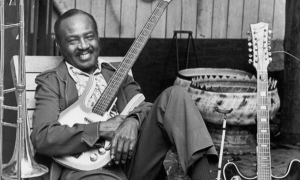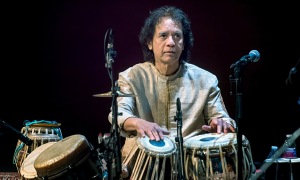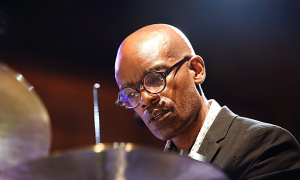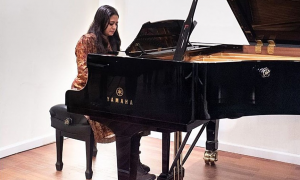Home » Jazz Articles » Under the Radar » The New Golden Age of Jazz Radio
The New Golden Age of Jazz Radio

Listeners in the jazz capital of the world have to look back to a church-owned commercial station for the likes of Charles Mingus, Miles Davis, Eric Dolphy, John Coltrane, et al. The historic Riverside Church at 120th Street and Riverside Drive opened its doors in 1930 and introduced the classical and jazz station WRVR (106.7) in 1961. Before long the format switched to all-jazz with Just Jazz being the station's flagship program. The program was hosted by Ed Beach, a native of Winnipeg, Canada who came to Manhattan in 1957 and built a loyal following. Beach was a tireless researcher but let the music do most of the talking throughout his two-thousand-plus hours of programming. He often played music that linked jazz to its African roots, featuring artists like Randy Weston and Ahmed Abdul-Malik along with broadly popular talent such as Louis Armstrong. Just Jazz ran from 1961 to 1976 and WRVR itself vanished in the summer of 1980, with no advanced notice to its listeners. If there was a golden age of commercial jazz radio in New York, it would be linked to WRVR. The new millennium has quietly seen a proliferation of jazz outlets in the U.S. Though hard to quantify because of the many varieties of mixed formats, there may be more terrestrial and web-based programming of jazz as of 2018-2019, then there has been in the past. All About Jazz itself is now a significant contributor to such programming.
Beginnings
The early development of radio was distinctly not American. Sharing a common purpose with the early drums of Africa and Asia, its purpose was strategic and tactical communication and signaling, and not entertainment. The early experimentation with electromagnetic waves was conducted by late nineteenth-century scientists whose names became part of the technological lexicon: Heinrich Hertz, Nikola Tesla, and Jagadish Bose. No pioneers were enthusiastic about the viability of radio waves, believing they would ultimately be limited to less than one-mile transmissions. Nobel Prize-winning physicist Guglielmo Marconi, generally credited as radio's inventor, successfully furthered the range of radio transmissions at the end of the 1800s. In 1900 Brazilian priest and inventor Father Roberto Landell successfully transmitted audio nearly five miles but the business sector continued to view radio as a point-to-point device. When David Sarnoff, a Russian immigrant, and protégé of Marconi, was rising through the ranks of the General Electric-owned Radio Corporation of America (RCA), he envisioned a broader application for radio. Sarnoff was a shrewd visionary; persistent and ruthless. In 1915, and again in 1920, he suggested the company develop a "radio music box" for the mass market, but the company delayed the project as a secondary priority. But Sarnoff, known to be indifferent to resistance, enlisted third parties to arrange the radio broadcast of a Jack Dempsey heavyweight boxing match in 1921. Three-hundred-thousand listeners tuned in and the success of the broadcast elevated Sarnoff's stature throughout the communications world, leading to meetings with Albert Einstein and other notable scientists. In 1922 he introduced the Radiola, a seventy-five-dollar home radio that would change the culture of the country.Smaller, regional broadcasts predated Sarnoff's boxing broadcast. Westinghouse founded a radio station, KDKA, in 1920, and in 1921, it initiated broadcasts of sports events. The oldest continuously operating radio station in the U.S. is Detroit's WWJ, 950 kHz. Beginning as a regional amateur station in 1920, WWJ was not supported by advertising but funded by the newspaper Detroit News and formatted to support print content with the "Detroit News Radiophone." The early success of mass-market radio broadcasts led to major monopolies dominating the ownership of stations. In 1926, RCA established the National Broadcasting Company (NBC) as a subsidiary managing its network broadcasting business. In early 1927 only seven percent of the nation's seven-hundred radio stations were affiliated with NBC. The same year, the Columbia Broadcasting System (CBS) was formed. The Mutual Broadcasting System was formed in 1934 and owned more than one-hundred affiliates by 1938. American Broadcasting Corporation (ABC) emerged in 1943 following a court-ordered breakup of NBC stations.
The Growth of Radio
Programming in the 1920s and 1930s was rarely single focused. The typical station broadcast news, sports, music, comedy, and drama series, and soap operas, so named because of soap company sponsorship. "Transcription Shows" were those featured local actors working a franchised script. The growth of radio in the 1920s and 1930s was rapid, especially when the Great Depression made the cost of recordings prohibitive. Data from the research firm Sterling and Kittross indicates there were five stations in the U.S. in 1921 and five-hundred, seventy-one in 1925. Similarly, advertising spend almost non-existent 1921, increased to almost five-million dollars in 1927 (the equivalent of over seventy million dollars in 2018) and the sales of home radio equipment, from less than fifty-million to more than four-hundred million dollars. A 1938 survey conducted by the Federal Communications Commission showed that of seven genres of radio programming, music accounted for over fifty-percent of broadcast hours.The escalating number of stations presented a logistical problem as they jockeyed for limited dial space. In 1933 American engineer Edwin Armstrong invented frequency modulation (FM) technology to eliminate the noise on the amplitude modulation (AM) band. AM stations were assigned in narrow proximity and would interfere with each other. The development of wide-band FM was tainted. According to Armstrong, RCA, and NBC, under Sarnoff's leadership, infringed on his copyright and paid him no royalties. Armstrong sued but Sarnoff had the resources to drag the case out, and for eight years it languished in the courts. Armstrong had to sell many of his possessions to continue the suit and when RCA finally offered a settlement, it wasn't enough to cover Armstrong's legal bills. Shortly afterward, Armstrong took his own life. Sarnoff's reaction to the suicide was to callously deny any culpability. The Sarnoff-Armstrong patent infringement case was well-publicized at the time but it was only one of a number patent suits filed in the early days of radio.
Jazz on the Radio
As was true of the heartland's reaction to jazz in general, jazz on the radio was not universally welcomed. Derek Vailant, in the collection of dissertations titled Radio Reader: Essays in the Cultural History of Radio tells of Earl Terry's campaign to save listeners from jazz. In 1925 Terry was the broadcast chief of Madison, Wisconsin-based WHA radio and took it upon himself to openly criticize his listeners' tastes and the cultural direction in which music was heading. Terry had an eclectic background; he was a local farmer who became a physics professor at the University of Wisconsin, a position he held concurrently with managing WHA. Appointing himself as station programmer, he vowed to shield listeners from "worthless music," even as he branded himself a "progressive." Terry was not an anomaly among the Midwest "reformers" who favored a regular diet of classical music. Jazz was tossed off as radio junk food, but more irritating to listeners was Terry's rejection of the popular songs of the reconstruction era. WHA, WWJ (Detroit), KDKA (Pittsburgh), KQW (San Jose), KNX (Los Angeles), KQV (Pittsburgh), and WRUC (Schenectady) are believed to be the oldest radio stations in the U.S. In most cases, news was the primary format for these early stations and though music programming came and went through the years, jazz was rarely a staple of programming.The Swing Era was developing ten years before its official christening in 1935. It marked a move away from jazz, to jazz-flavored pop music. For the first—and only time—jazz, of this cheerfully watered-down variety, dominated radio play, occupying the middle years of the two-decade Golden Age of Radio. In the early part of the 1930s, the major networks voiced strong opposition to playing records on the air and the advent of disc jockeys was ten years away. If early jazz programming met with resistance on smaller radio stations in rural America, and in smaller cities, the major networks—NBC and CBS in particular—saw big band jazz as an economic opportunity. Through their hundreds of national affiliates, they fed a voracious public appetite for dance music that helped ease the psychological wounds of the Great Depression. In Music Radio: The Great Performers and Programs of the 1920s Through Early 1960s (McFarland & Company, 2005), author Jim Cox points to a specific radio event that launched radio's big band phenomena. In the summer of 1935, the U.S. economy had just begun a slow recovery and as cautious optimism took hold, CBS radio broadcast a Benny Goodman Orchestra performance from the famous Palomar Ballroom in Los Angeles initiating a radio trend that would last through the next ten years. The Palomar itself became a base for such broadcasts as the groups of Tommy Dorsey, Glenn Miller, Artie Shaw, and many others who were featured on evening radio broadcasts from the local station KFLJ. A number of concerts by Kid Ory's Sunshine Orchestra performed on a short series of remote broadcasts from the Plantation Club in Los Angeles in 1922.
In 1929, as the Great Depression set in, radio listeners craved nostalgia; pre-devastation comfort music for the ears. For a large swath of the U.S. that music was not jazz but roots music—gospel and blues were initially the most popular broadcasts on radio and the country-western genre gained popularity with listeners. Chicago's WLS radio began to broadcast a program called Barn Dance in 1924. The country-western formatted show quickly became so popular that it gave birth to a successor, National Barn Dance broadcast—beginning in 1925—on WSM in Nashville, a station with bandwidth greater than WLS. Within its listening area patrons would gather for square dances called over the radio. As the program evolved, some Swing and Western Swing made their way into the mix. Western Swing was, in the minds of many listeners and station managers, an off-shoot of country but musicians came from backgrounds that included regional swing styles, Dixieland, and jazz. By the 1930s big band music had become America's pop music and its presence on the airwaves was ubiquitous nationwide. By the power and popularity of their music, some black bandleaders began to breakdown the racial barriers of radio. Along with white bands of Benny Goodman, Paul Whiteman, Glenn Miller, and the Casa Loma Orchestra, the bands of Cab Calloway, Count Basie, Louis Armstrong, Fats Waller and Duke Ellington had notable success on white-owned stations. But others, such as Fletcher Henderson, whose record company didn't promote him, were less likely to be heard. Big band leaders became such recognizable fixtures on radio that many were identified by particular theme songs. Cox (Music Radio) cites Armstrong's "When It's Sleepy Time Down South," Basie's "One O'clock Jump," and Ellington's "East St. Louis Toodle-oo" and "Take the A Train" as some of the many avatars for fans.
KDKA in Pittsburg began a long-running program—the Uncle Ed Shaughency show—in the 30s and featured big band music daily, throughout the swing era. Cox suggests that some popular bandleaders of the era were not enthusiastic about broadcasting their performances. Paul Whiteman believed that radio would not elevate performers' status, and would likely reduce the number of paying customers at shows. Those possibilities did not stop hundreds of lesser-known bands from seeking radio coverage. To satisfy audiences on both coasts in the days before recorded performances, live shows were often marathons that could last over five hours with the same audience.
Early radio shaped a larger audience for African American musicians but it was far from color-blind. In the 1930s over three-quarters of all U.S. blacks lived in the South, outside urban areas, and they were with few exceptions impoverished. While radio ownership proliferated, ownership was mostly white; programming, including the music made by African Americans, was targeted to the white audience. In the mix were early jazz, minstrel style shows and other "entertainment" such as Amos 'n' Andy, a degrading black stereotype comedy so wildly popular among whites it ran from 1928 until 1960 with forty-million listeners. The setting of the show was moved from Atlanta to Chicago, to Harlem and the black characters were voiced by white actors. The original program was launched from WMAQ, the Chicago radio outlet, and at the peak of its popularity in the early 1950s, it was adapted for television but only ran for two years. The theme song for the radio and television versions was taken from the score of the infamous white supremacist movie, Birth of a Nation (1915). In 1930, RKO Pictures produced Amos 'n' Andy film with the radio stars in blackface. Ironically, the movie, which was widely panned, included a scene with Duke Ellington and his orchestra.
Radio broadcasts, by and for the black audience, began in small measure, in 1929 with The All-Negro Hour, a program that pushed away from the minstrels of white radio to focus on genuine African American music. Hosted on WSBC in Chicago, the station hired Jack Cooper, believed to be the first African American announcer in the U.S. Copper also produced the program. In 1929, three of Chicago's most populated neighborhoods were between seventy and ninety percent black. In the late 1940s and early 1950s radio lost many listeners to television, the next technological frontier for those with disposable income. Advertisers of the time recognized that African American consumers were increasingly positioned to fill the radio void. To best address this market, stations had to quickly address the lack of programming and black radio personalities. In Legendary Pioneers of Black Radio author Gilbert A. Williams explains that in 1951 new ground was broken by NBC which instituted an integration policy for its affiliates that increased on air black talent by two-hundred-percent. In 1949 WDIA in Memphis hired an all-African American announcing team and WERD (Atlanta) became the first black-owned station in the country. "Rhythm and Blues" programs drew mixed-race listening audiences to black hosts and black urban music.
Other Significant Stations
WNEW-AM in New York was, for many years, considered one of the most successful radio stations in the U.S. From around 1938 through the late 1950s jazz figured prominently in the programming mix, which included talk and news. The station favored big band and especially singers in the Great American Songbook tradition. However, a popular late-night DJ named Art Ford was reportedly fired for playing "too much jazz...." WBGO (88.3 FM) first aired in 1948 and is a public radio station based in Newark, New Jersey but with its transmitter in Times Square. Billed as "Jazz 88" WBGO is not solely dedicated to jazz. The station hosts several talk/news/information programs and a blues program and one dedicated to rhythm and blues. The jazz programs tend toward traditional mainstream artists. The station's FM signal has always been spotty and some complained that their 2011 switch to a new transmitter did nothing to improve reception. Now broadcasting on the web, the problem is resolved for listeners with internet access.The bastion of jazz radio is the university system. Temple University has an unprecedented six stations —WRTI, WRTJ, WRTL, WRTQ, WRTX, and WRTY—all dedicated to jazz. KCSM is owned by the San Mateo Community College District and serves the San Francisco Bay Area from studios at the College of San Mateo. The commercial-free station broadcasts jazz music, twenty-four-hours a day. There are many hard to catalog local stations such as WXHQ-LP (105.9 FM). The fifty-watt station serves only the Newport and Providence, Rhode Island area and plays jazz, blues, R & B, bossa nova, Afro-Cuban, lounge, soul, funk, reggae, ska, electronic, downtempo, acid-jazz, surf, world, country, folk, and rock. A public station, WXHQ has a policy of not playing music that features English language vocals. They provide radio coverage of the Newport Jazz Festival. There are approximately eighty to one-hundred jazz radio stations in the U.S. as of 2018 data. About seventy stations bill themselves as "mainstream" jazz or a combination of mainstream/smooth, or mainstream/fusion, and forty of these stations are affiliated with a college or university. The majority are member-supported, public radio stations and very few offer round-the-clock jazz programming but offer a mix that may include classical music, news, and talk. All About Jazz hosts podcasts and radio programs daily, currently offering ten programs as of late 2019. The webcasts are available on the All About Jazz home page.
Related Discography
The four discs below represent different time periods and styles of jazz, all captured from the original radio broadcasts.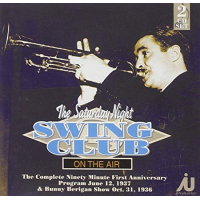 Saturday Night Swing Club 1 & 2: Various Artists
Saturday Night Swing Club 1 & 2: Various Artists(Jazz Unlimited, 1999)
The cover implies this double-CD is a Bunny Berigan release but there are tracks from Django Reinhardt, Stephane Grappelli, Benny Goodman, Claude Thornhill, and others. There are forty-one tracks over nearly two hours and all are from—presumably—various radio broadcasts and stations. The original recordings are from the 1930s and the quality is spotty.
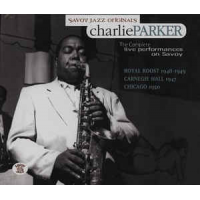 Best of The Complete Live Performances on Savoy: Charlie Parker
Best of The Complete Live Performances on Savoy: Charlie Parker(Savoy Records, 2009)
Before it closed in 1958, Harlem's Savoy Ballroom hosted prominent jazz artists and drew in celebrity fans for over three decades. This album features 1948 and 1949 Parker performances broadcast for an unspecified radio station, but a well-known disc jockey of the time, Sid Torin ("Symphony Sid"), at was then at WMCA-AM 570 and appears on the broadcast as a host. A young Miles Davis plays on the first half of the album and Kenny Dorham on trumpet for the latter tracks. Milt Jackson, Max Roach, and Al Haig are on board. Many of Parker's familiar tunes are here, including "Koko," "Groovin' High," "Chasin' the Bird" and "Anthropology" along with compositions from Thelonious Monk, Davis, Dizzy Gillespie, Tadd Dameron, and Lester Young. The remastering and packaging are impressive.
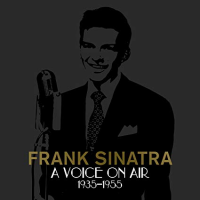 A Voice On Air 1935-1955: Frank Sinatra
A Voice On Air 1935-1955: Frank Sinatra(Sony Legacy, 2015)
A four-disc box set covering twenty years of radio broadcasts from Frank Sinatra. The crooner focuses on swing here and is backed up by the big bands of Harry James, Tommy Dorsey, Alex Stordahl, and others. He performs thoughtful duets with the likes of Doris Day, Peggy Lee and Nat King Cole and some gimmicky nonsense with Bob Hope, Jimmy Durante, and one-time Louisiana governor Jimmie Davis; a legitimate singer, but not necessarily here. In these many tracks Sinatra covers familiar ground, including many staples of his career. Some unnecessary filler appears in radio commercial jingles and comedy pieces. For Sinatra fans, the quality of this Sony Legacy collection is excellent and the originals had not been heard since the radio programs.
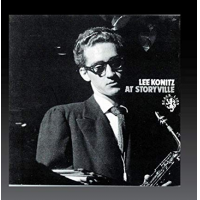 Jazz At Storyville: Lee Konitz
Jazz At Storyville: Lee Konitz(1201 Music, 1984)
The album, recorded live in 1954 at Boston's Storyville Club for WHDH radio, features the alto saxophonist Lee Konitz at the start of his solo career. Konitz had been a sideman for his mentor Lennie Tristano before leading this quartet with pianist Ronnie Ball, Percy Heath on bass, and Alan Levitt on drums.
References
- Lazarfeld, Paul. Radio and the Printed Page. Paul, Ulan Press (2012)
- Scott, Carole. "History of the Radio Industry in the United States to 1940.
- EH.Net Encyclopedia, edited by Robert Whaples. March 26, 2008.
- Dreher, Carl. Sarnoff, an American Success. Quadrangle/New York Times Book Co; 1977
- Radio Reader. Michele Hilmes (Editor), Jason Loviglio (Editor). Routledge; 1 edition (2001)
- Music Radio: The Great Performers and Programs Of The 1920s Through Early 1960s. Jim Cox. McFarland & Company; (2005)
- Williams, Gilbert A. Legendary Pioneers of Black Radio. Praeger, 1998
Tags
Under the Radar
Karl Ackermann
Grover Washington Jr.
george benson
Dave Grusin
Candy Dulfer
David Sanborn
Bob James
Mindy Abair
Chuck Mangione
Spyro Gyra
Kenny G
Charles Mingus
Miles Davis
Eric Dolphy
John Coltrane
Randy Weston
Ahmed Abdul-Malik
Louis Armstrong
Benny Goodman
Tommy Dorsey
Glenn Miller
Artie Shaw
Paul Whiteman
Cab Calloway
Count Basie
Fats Waller
duke ellington
Fletcher Henderson
Bunny Berigan
Django Reinhardt
Stephane Grappelly
Claude Thornhill
Kenny Dorham
Milt Jackson
Max Roach
Al Haig
Thelonious Monk
Dizzy Gillespie
Tadd Dameron
Lester Young
frank sinatra
Harry James
Lee Konitz
Lennie Tristano
Ronnie Ball
Percy Heath
Al Levitt
PREVIOUS / NEXT
Support All About Jazz
 All About Jazz has been a pillar of jazz since 1995, championing it as an art form and, more importantly, supporting the musicians who make it. Our enduring commitment has made "AAJ" one of the most culturally important websites of its kind, read by hundreds of thousands of fans, musicians and industry figures every month.
All About Jazz has been a pillar of jazz since 1995, championing it as an art form and, more importantly, supporting the musicians who make it. Our enduring commitment has made "AAJ" one of the most culturally important websites of its kind, read by hundreds of thousands of fans, musicians and industry figures every month.







